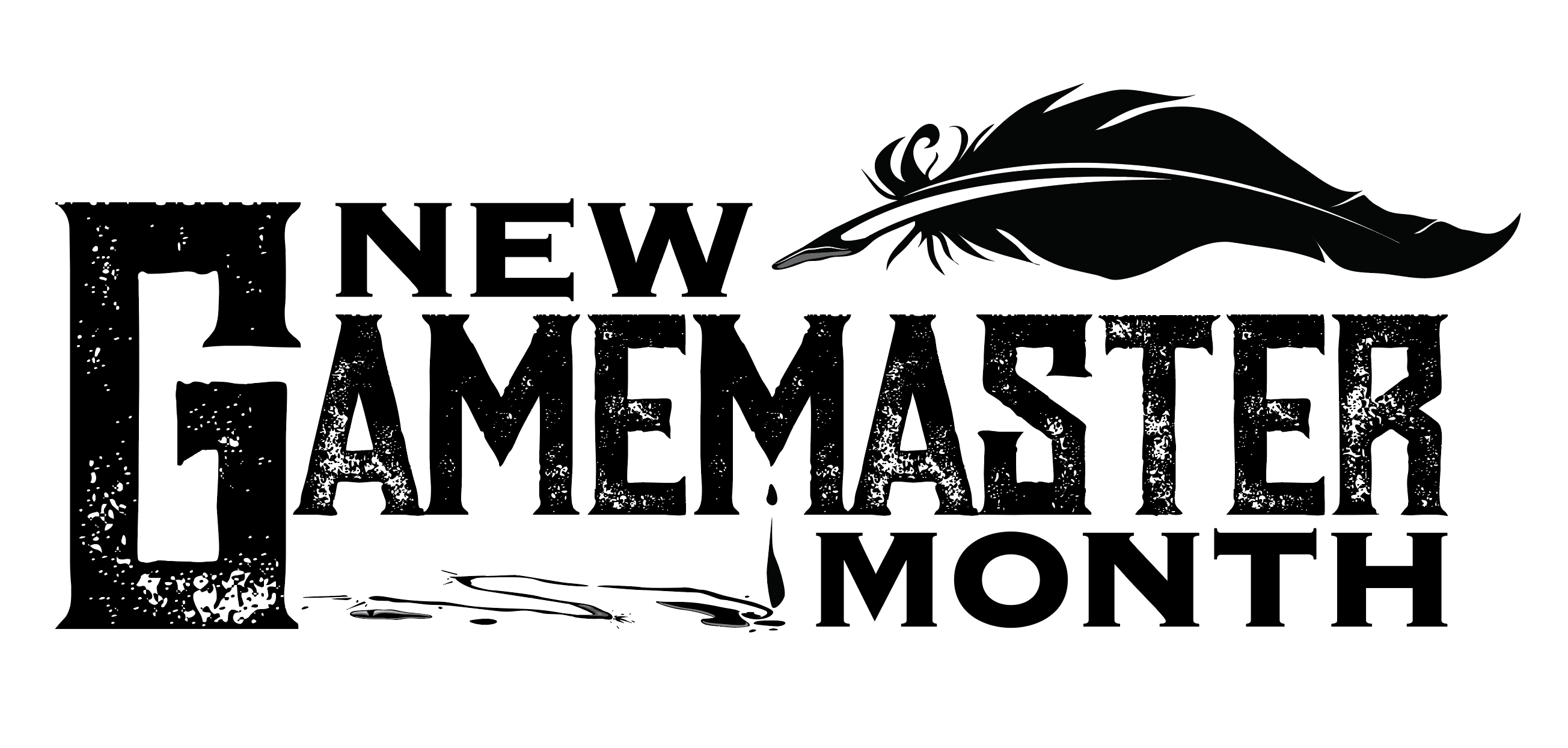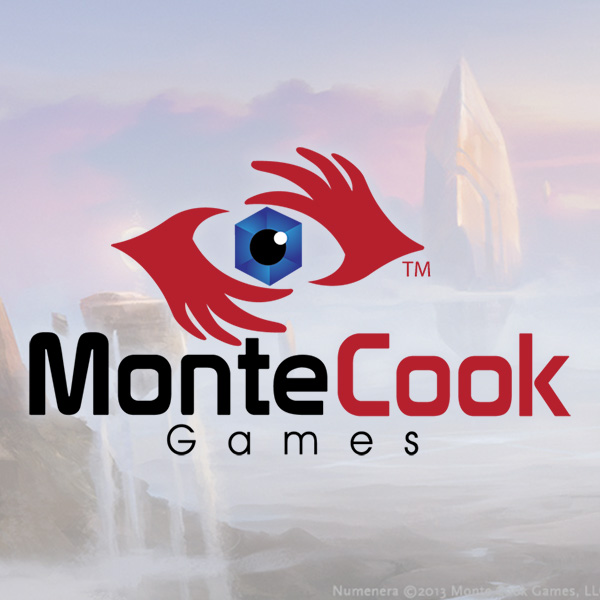This is the sixth installment of New Gamemaster Month!

In New Gamemaster Month we’re helping players who feel the urge to run an RPG—to become a GM for the first time—take the plunge. If you’re just joining us, start with the first installment. Then join us every Tuesday and Thursday throughout January, and by the end of the month you’ll be a GM too!
We talked on Tuesday about encounters and their importance to the unfolding narrative of your game and the pace of play. Today we’re going to dress things up just a bit, by talking about the details that bring an encounter to life.
Details, Details
Details really amount to two things: informational details, tangible details, and descriptive details. OK, that’s three things. Nobody expects the Spanish Inquisition.
Informational details include stats for creatures, maps of locations, details about the difficulty of a challenge, and names, descriptions, and personalities of NPCs.
How much effort you put into these details is up to you. Not enough, and you’ll slow yourself down “winging it” as the encounter unfolds. And just like a missed retort, you may find yourself thinking an hour or a day later of what you wished you’d said at the time. On the other hand, too much detail wastes your time and energy, and often presupposes a particular manner in which the scene is intended to unfold—a manner that may not be the route your players take.
A well-designed encounter should at least have the following informational details:
- A map, if the lay of the land matters (this is most often the case in encounters likely to involve combat, and then usually when there’s something unusual or tactically interesting about the situation).
- The names of the important NPCs involved, and maybe some notes on their appearance, personality, attitude, and/or likely reaction to the characters.
- Game stats for any creatures or NPCs the characters are likely to go up against (in a fight or in any other form of contest).
- The mechanisms and difficulties of any traps or environmental challenges present.
By tangible details, I mean things you can give or show the players. Sometimes an adventure will include illustrations specifically intended to show the players (a technique pioneered by the famous Tomb of Horrors adventure for D&D back in the day). There may be maps the players can keep, or props such as letters or other handouts. Even an illustration of a creature to be confronted can be handy. Your game doesn’t require this stuff by any means, but they can be useful and entertaining, and can sometimes save time (having a map they can refer to helps players understand the area with less confusion and without questioning you over and over, for example).
Finally, there’s descriptive details, and this is where the art of GMing really shines. The informational and tangible details are largely a function of the adventure itself—in most published adventures, you get all the names and stats and NPC attitudes you need. And you’ll get some description, too, but what you do with it is what can make you a good—or even a great—GM. And that brings us to our activity for this session. . .
Running Your First Game Virtually
Just like a virtual business meeting or class, in its simplest form, an online game need not be too different from an in-person game—instead of gathering around a table, you’re gathering in a video conference, but the activity is pretty much the same.
In its more complex form, an online game may involve digital maps, tokens, character sheets, handouts, creature stats, dice rolling, and more.
Either way, it’s smart to recognize the strengths of the medium. There are some things that are easier to do in a virtual environment than in person, and a lot of them pertain to the sorts of “tangible” details discussed above.
- If your game involves secrets, or even situations where different characters perceive things differently, use direct messaging to deliver info to select players. You can even draft some messages ahead of time, to cut-and-paste quickly so you don’t slow the game typing them out.
- Digital handouts are easy to share, as well as illustrations of scenes or creatures. If you’re working from a PDF of your adventure, you can screen-grab the image from the book to show your players. (Always respect the intellectual property of the creator, though. Sharing a digital snippet with your players during a game is generally an acceptable use, but larger portions, or more public sharing, disrespects the creator’s legal rights.)
You’ve already read Taker of Sorrow, but for this activity you’re going to read some of it again. In particular, read through the prelude encounters (Taking a Toll and Ravage No More), along with the numbered encounters that make up the body of the adventure.
As you read, think about how you’ll portray locations and NPCs. Imagine them in your head; give them voice. Picture the scene: Is it dusk? What color is the sky? What are the sounds and smells in Vesburgh? Do children run underfoot? Can you smell cooking, or hear the crying of a baby from a local house? Is Gram similar, or does it have a different atmosphere? What details convey that feeling?
Spend three or four minutes per encounter just imagining what it might be like. It’s OK to take some notes if you’re struck with a particular inspiration, but don’t overdo it, and here’s why: It’s very likely the encounter won’t play out exactly as you’re imagining, and you don’t want to overly commit yourself to a specific vision. But having something in your head—something with details and atmosphere—gives you the means to bring these encounters to life.
While we’re at it, read and bookmark these creatures:
- Murden (page 243)
- Teratoma (in the text and sidebar of page 367)
- Weymel (sidebar page 375)
This time the purpose is two-fold: It’s good to have a look at the stats, to prep yourself with what the creatures’ capabilities and likely tactics are. But this reading also serves the purpose just mentioned. Think about the teratomas—how will you describe them? Do they lurk in the shadows at first, or rush aggressively at the characters? Are there any sounds or smells or visual details that come to mind? Imagine them, so that when you unveil them to your players, you do so with color and excitement.
Feel free to share your imaginings at the New Gamemaster Month Facebook group —you might find some inspiration there, too!
That’s it for this activity. Come back on Tuesday for the final week of New Gamemaster Month. You’re going to be running your first game soon—and it’s gonna be great!
One easy thing about being a GM for Unknown Armies is that it’s set in the modern world. Instead of trying to explain an arcane device that permits both long-distance communication and instant research, you can just call it a phone. However, you can use weird details to really make the game work.
Spicing Up the Weirdness
There are many wondrous, unsettling, and frightening things in a typical Unknown Armies game. That’s why details are important. By adding weirdness between the mundane realities of life, you make things even more unsettling because it feels more real.
Talk about a giant two-headed dog, and everyone asks, “Right, how do we get past it?” But talk about a library full of books but with one shelf empty except for a statue of a miniature penguin, and suddenly players start asking, “Why is that there? Should we touch it? Should we even go near it?” Mix in a little strange with the familiar, and you can bring some mystery to the game.
When you start creating encounters for your players, write down some mundane and weird details as appropriate. Think about your five senses as you add details for each encounter. Don’t use all five at once! But the smell of motor oil in a kindergarten classroom or the sound of dishes being washed in an otherwise empty kitchen will make those scenes much more interesting.
Characters Need Details Too
When it comes to GMCs (characters that you will play as you interact with the players’ characters), create some GMC file cards. These are index cards or small text files that list details you can use to help those GM character feel real. Leave plenty of space because you can add more details as you play the game.
Your activity this time is to create some details about your locations, unnatural entities, and GMCs. You don’t have to go crazy — not every GMC needs a long backstory — but little things like a odd smell, sound, or sensation can really turn something normal into something players will keep talking about.
Feel free to share some of your details with other GMs at the New Gamemaster Month Facebook page. Maybe you can help other GMs get into this as well. We’ll talk next Tuesday about what items you should bring to the first game session. Until then, start experimenting with cool details you can add to your descriptions. Write them down so you don’t forget!
For this step, reread Midnight Sub Rosa and think about how you’re going to bring the setting to life. Consider the various characters you’ll have to play – Sheriff Barnes, Professor Derby, Irma Derby, the various guests, the ghouls… and think about how you’ll portray all these different roles. You don’t have to be an actor – some GMs prefer to describe how their Non-Player Characters behave, instead of putting on their voices and mannerisms – but you need to bring them to life in whatever way works best for you. For each character, write down one or two things to keep in mind when playing them. Maybe a gravelly voice would work for the Sheriff. Maybe you’ll keep both your hands folded on your lap and look down nervously when playing Irma.
For example, when I run this scenario, I ham up the part of Jack Starling outrageously, playing him as an over-the-top self-proclaimed master of the mystic arts. For the ghouls, I keep them ‘off-screen’ as much as possible, never letting the players get a good look at them. I describe parts of them – a claw smashing through a window, teeth gleaming in the moonlight, hoofprints in the dirt, a fearful stench – but never put everything together, never let the players be sure if there’s one monster or ten out there.
Also, take a mental walk around the town of Rosa and the key locations like the Derby house. The scenario gives some details, but you can invent and add your own. Who might the Investigators meet if they wander the main street? What’s in the attic of the lodging house? Where does Pastor Sperry go at night?
If you have time, turn to the history books and the internet. Looking at a few photographs from the period can add a wealth of detail to your descriptions.
Hopefully you’ve already read through “A Rough Landing” by now, but for this activity you’re going to read some of it again. In particular, read through the Opening Scene: At the Market (pages 6–11) and Meeting With the Law (pages 12–14). These are the first two scenes and may contain combat, negotiation, and roleplaying.
As you read, think about how you’ll portray the locations depicted. The Starter Set has a map of Jonstown, so you can lay it out on the table if need be, showing them the areas depicted. Furthermore, the adventures themselves cover the market and the City Rex’s office/home fairly well, so they are easy to describe to the players.
Now imagine the significant nonplayer characters, particularly Faran the young town guardsman, the angry troll mercenaries and the great troll Hungry, and finally, stern Jorjera Latish, administrator of the city. Imagine them in your head; give them voices. Maybe even imagine them as if they were cast in a movie, and try to portray them through accents or body language.
The adventure presents time of day and describes the setting, but you should feel free to extrapolate or change details as needed. Picture the scene in your head and imagine how you’ll describe it, appealing to as many senses as possible. It supposes that the adventures arrive late in the evening. Think about what it’s like when a market shuts down. Everyone just wants to get home, and having someone cause trouble is the last thing anyone wants. When in doubt, skew for the dramatic. The adventure doesn’t say so, but maybe it’s going to rain soon and everyone’s trying to speed things up to avoid the rain, when the trouble starts.
Furthermore, depending on who’s there of the adventurers, think of how the encounter with the trolls will play out differently. Vasana, for example, doesn’t like her Honor insulted, and she won’t stand by and watch innocent merchants get hurt. Harmast is an excellent fighter, but he’s also frequently trying to talk his way out of trouble, as his patron god is the god of Trade and Communication.
Involve the adventurers. Have a merchant pull on one of their sleeves, or have a stray thrown fruit splat onto one of their tunics, or a fleeing chicken flutters up into their arms, just as a troll lurches towards them.
However, this encounter is also in a public square and hasn’t escalated past being a public nuisance, a low-stakes sort of fight that, even if things become violent, might not end up in anyone getting killed. Even though the dark trolls are hardened mercenaries, they are not bloodthirsty killers, and they’re drunk and mad, not berserk or filled with rage.
Spend three or four minutes per encounter just imagining what it might be like. It’s okay to take some notes if you’re struck with a particular inspiration, but don’t overdo it, and here’s why: It’s very likely the encounter won’t play out exactly as you’re imagining, and you don’t want to overly commit yourself to a specific vision. But having something in your head—something with details and atmosphere—gives you the means to bring these encounters to life.
Take a look at the dark troll mercenary stats (page 10) and the stats for Hungry (page 11). Know what they’re capable of and how they’re likely to fight.
This time the purpose is two-fold: It’s good to have a look at the stats, to prep yourself with what the foes’ capabilities and likely tactics are. But this reading also serves the purpose just mentioned. Think about the dark trolls—how will you describe them? Are they entirely focused on their rampage, reluctant to give it up, or do they rush aggressively at the adventurers the moment they intervene? Are there any sounds or smells or visual details that come to mind? Imagine them, so that when you unveil them to your players, you do so with color and excitement.
As mentioned above, this encounter is relatively low-stakes and can resolved without much risk, but you can increase the threat the dark trolls present by increasing their number or having them gang up on individual adventurers, rather than spreading them out. If the encounter becomes boring or drags on too long, or goes badly for the player character adventurers, have the city guard show up sooner. Pay attention to when the players are having fun, or when they’re tuning out, and adjust your adventure accordingly.
Feel free to share your imaginings at the New Gamemaster Month Facebook group—you might find some inspiration there, too!
That’s it for this activity. Come back on Tuesday for the final week of New Gamemaster Month. You’re going to be running your first game soon—and it’s gonna be great!
Locations and Bystanders
Your monsters and minions are what makes the adventure suspenseful, but your bystanders and locations make the mystery come to life. The basic Mystery structure starts with investigation. That allows the hunters to learn enough about the monster and its weaknesses that they can (hopefully) defeat it. It’s important to make the investigation segment exciting, not just an obligatory slog before a cookie-cutter fight. Monster of the Week is not a rigidly-procedural fighting game. It’s a game of weird mysteries and unexpected action. You can make those mysteries come to life by giving your hunters opportunities to interview bystanders and investigate locations.
As we covered previously, each threat has a motivation. Motivations are simple, powerful cues that help you portray the various characters, creatures and locations the hunters encounter.
Our example adventure “Dream Away the Time” includes five locations in and around the town of Handfast, and one in Faerie should the hunters decide to go through a portal. Four are location types that are conducive to gathering information (crossroads or hub) and two are more likely to provide obstacles to overcome (wilds, maze). All of them consist of a short description that conveys what’s unique about the location’s atmosphere. Each is designed to provide a framework for you to describe what the location is like, but also give you the room to custom tailor its features and challenges to your group.
The Mystery also has a dozen named bystanders with different motivations which may cause them to help or impede the investigation. John Chilton may be suspicious and stubborn about dealing with Hunters while his wife Alice is eager to help and join in the hunt.
Each character has a short description which includes their dominant traits, and a list of any relevant information they can pass along to the Hunters. This might be the result of a successful investigate a mystery move, but if the players ask the right questions, it’s not “cheating” to skip the roll and have the character share their info. A good general rule of GMing: it’s better to share information than withhold it.
Finally, the players are going to talk to people you didn’t expect to depict. It’s amazing that if you drop a seemingly innocuous detail into the Mystery, the players will immediately become fixated on it. (“Oh there’s a bait shop!? We go in and talk to the lady behind the counter!!”) Fortunately, page 161 provides a list of elements (key traits, types and motivations, names) you can draw from to spontaneously create bystanders as needed in response to your hunters’ actions.
You can also fall back on random name generators and lists of traits available online when the players ask for something not already in your notes. We particularly like the collections from Seventh Sanctum and Abulafia.
Pro tip: Write down the names of bystanders you spontaneously create so they’re available to show up later. It gives your mystery a sense of coherence and structure when named characters reappear. And if you give your bystander a memorable trait or motivation, then most players will never know the difference between a bystander you had in your notes and one you made up on the spot.
Sections to (Re-)Read: Introductory Mystery: Dream Away the Time: Threats (pages 152-161).
If You’re Using Roll20
You can use the Keeper Mystery Sheet to store additional notes, such as sample quotes, or what kind of information a bystander can pass on.
Character tokens come in handy to represent the hunters, monsters, minions, and bystanders. We recommend RollAdvantage’s free Token Stamp tool to create tokens by just dropping any image into the template. On Roll20, hunter tokens can be linked to the hunter sheets.As for locations, you can represent them using illustrations or maps placed on the Map & Background layer.
As for locations, you can represent them using illustrations or maps placed on the Map & Background layer. In the Dream Away the Time Roll20 module, we include eleven high-resolution background scenes, locations, and maps plus a blank frame for your own images. We explain how to use them on the Keeper’s Crypt page.
It’s time for your players to create their Agents and for you to weigh how they are likely to interact with the world of Delta Green.
Earlier, we learned to facilitate encounters using Delta Green’s simple rules:
- Primary Objective: Read the combat and sanity rules on pages 34–37.
- Bonus Objective: Consider other possible threats to safety and sanity that Agents might invite upon themselves. Prepare accordingly.
Now let’s look at the Agents who are at risk.
Agent Creation vs. Pregens
Did you and your players decide for them to create their own Agents or use the pregenerated Agents in Need to Know?
If you’re using pregens, you’re done.
The pregenerated characters in Need to Know have all the ingredients they need for a great game.
If you’re creating new characters, do it as a group.
Give every player a copy of Delta Green: Need to Know and ask them to not read “Last Things Last,” pages 41 onward. Work as a group over email or in chat meetings to build characters and their relationships with each other and with Delta Green.
Working as a group lets the Handler walk new players through the rules and through character creation. It helps them learn about the character sheet (pages 13–14) and how to create characters (pages 16–18). It allows you to answer clarifying questions about the rules for your players, as you will likely be more experienced with the book overall.
Working together brings all the players’ perspectives into play. Their imaginations can inspire each other.
Working together makes for a more successful group. They can learn each other’s strengths and weaknesses.
Lastly, completing character creation as a group reduces the amount of preparation required for you, the Handler.
Take secret notes on each Agent’s Bonds and personal history.
The players are your partners in playing Delta Green and in creating a shared story of terror. Their Agents are your victims. Agents created from scratch are the victims we all care about the most.
Players tend to have a far deeper emotional investment in characters they create themselves. Note details and especially dangerous secrets that could be used as hooks or as leverage to influence or coerce them. Those may come out in “Last Things Last.”
Nonplayer characters are your primary tools to create the world.
Delta Green is all about mood. How do you corrupt the atmosphere of the game into something malignant?
Successful Delta Green games live in the details. Short, evocative descriptions are tools to steer the game’s tone toward the horrific. The majority of the text in the scenario is dedicated to that task.
Even more importantly, how you play NPCs can help players fall into the dangerous world of their Agents. Use the appearance and affect of NPCs to build up the inescapable reality of Delta Green’s world.
In narrative terms, characters played by the Handler are “flat.” Though they may have lives that exist outside the scenario, it is unlikely a player will ever engage with all that. That means most nonplayer characters rarely change over time. For the Handler, all this is good. It makes it easy to keep track of things. More importantly, it gives the Handler easy access to a chorus of voices to communicate the reality of the situation to the Agents.
In “Last Things Last,” the easiest means the Handler can use to build terror is the creature inside the tank.
There are only three NPCs in “Last Things Last”: the nameless case officer at the post office, Mrs. Jancowitz in the apartments, and the monster Marlene at the cabin. Marlene likely spends the most time talking to the Agents. The scenario does a great job detailing how, exactly, the beast tries to escape (pages 45–46). For now, keep these simple rules in mind: If the Other is smart enough to hop dimensions and pilot alien anatomies, it’s smart enough to trick a few humans.
That Which Was Marlene does everything in its power to escape. If its lies are discovered, it moves on to fresh deceptions. If those are revealed, it seasons new falsehoods with cosmic and personal truths no mortal creature should know. Marlene will promise anything to get out of the tank. As the Handler, it’s your job to make the case as convincing as possible and to explore the consequences for Agents swayed by false promises.
Set out with the goal that, even if Agents leave without ever opening the tank, they leave knowing they’ve encountered true evil. There are no happy endings with Delta Green. Only some less bad than others.
Gather “dirt” on your Agents.
The Other knows much. If you’re using the pregenerated characters, skim their character sheets now (pages 20–31). Look especially at the “Bonds” and “Personal Details and Notes” sections.
If the Agents realize Marlene is not what she claims, what information can be the Other offer in order to secure its freedom? What past regrets can it promise to erase? The more personal the leverage, the better.
Repeat this step if the players decide to make their own Agents. Take notes as they build their characters.
Actionables
- Primary Objective A: Decide, once and for all, if the group is using pregenerated Agents or creating their own
- Primary Objective B: Walk players through selection of pregens or character creation.
- Primary Objective C: Take notes on their personal secrets, Bonds and other relationships, and traumas in their history
- Secondary Objective: Imagine the voice and appearance of the three characters mentioned in “Last Things Last.” Especially Marlene.
Welcome back to another session of New Gamemaster Month using Tales of the Valiant rules.
You’ve already read Impregnable Fortress of Dib. Today, you’ll look at it again with an emphasis on how to portray locations, nonplayer characters (NPCs), and encounters.
Doing this thinking in advance helps plant important details in your mind when the game is live and there are fifty other things to think about.
Locations
As the game master (GM), you act as a narrator moving through the adventure. If you have a complete picture of the scene, you can help give it to your players too.
A good practice is to consider the five senses every time characters enter a new location:
- What do they see?
- What do they hear?
- What do they taste?
- What do they feel?
- What do they smell?
This approach provides a strong foundation for your descriptions and delivers subtle information to the players. It can also prompt story-based rolls. For example, a WIS (Perception) check can reveal more than what a character initially sees. The Impregnable Fortress of Dib mentions that the moat around Dib’s fort is a “noxious stench.” Is that because it’s filled with putrid trash, bodies, or something worse?
Setting the tone engages your players and helps them immerse themselves in the game. Consider these questions: Is it dusk? What color is the sky? What sounds and flora are found in the Blind Hills? Do travelers often use this road? Can you smell Dib’s hot oil or hear the chatter of goblins from inside his fortress? How does the atmosphere shift as they approach? The more sensory details you communicate, the more players have hooks to participate.
Spend 3 to 4 minutes per encounter imagining what it might feel like. It’s fine to jot down notes if inspiration strikes you, but don’t go overboard. Keep in mind that your players will likely approach the encounter differently than you envision, so avoid committing to a specific outcome. However, a detailed, atmospheric idea in your head allows you to bring encounters to life, enabling your players to take action and build on the story you started.
NPCs
NPCs are the domain of the GM. It is crucial to understand who they are and their purpose in the story. Visualize them clearly in your mind; give them distinctive voices, quirks, and behavioral tics. Make brief notes for yourself as a GM to ensure you don’t forget these details during the game, but if you miss them or forget in the moment, it’s fine. You can add them later or do something different. The players will never know!
Impregnable Fortress of Dib is light on NPCs, but the introduction narrative is told from the perspective of someone who “traveled the old trad road up near Blind Hills” and witnessed Dib’s wagon in the ditch. Consider who this person is and when in the story they’ll relay this information. And don’t forget Dib himself! He’s the “boss” of the adventure, so maybe practice a voice or catchphrase to make him distinctive and worthy of all the player characters’ (PCs) effort.
Encounters and Monsters
Next, take some time to examine the combat encounters in the adventure. The attack on Dib’s fortress is a significant part of the adventure. The adventure details special attacks the goblins can make while inside the fortress and highlights the differences between encounters underground and those outside the wagon.
If the PCs encounter any goblins, you can refer to the free stat blocks available at BFRD.NET:
- Goblin stat block: https://bfrd.net/monsters/goblin
- Dib, goblin captain stat block: https://bfrd.net/monsters/goblin-captain
The purpose of this review is twofold: first, it helps you understand the stats, preparing you for the creatures’ capabilities and likely tactics. Second, it encourages you to think about the goblins—how do you describe them? Do they use good tactics or rush aggressively at the characters? What sounds, smells, or visual details come to mind? Visualizing these aspects allows you to present an engaging and vivid experience to your players.
Feel free to share your ideas in the New Gamemaster Month Facebook group or on the Kobold Press Discord—you might find inspiration there as well!That’s it for this week. Come back Tuesday for the final week of New Gamemaster Month. You’ll run your first game soon, and it’s going to be great!
Blood on the Range is a simple adventure by design, which leaves a lot of room for improvisation and additions in the moment.
One of the things to fill in are descriptions of the Wyoming ranch most of the action takes place on, Heath Crittenden, and his three remaining ranch hands. Crittenden could be young or old, mean or pleasant, and you can practice a voice that matches those details. The ranch hands can be anything Crittenden isn’t. Broad cowboy accents are fun and help everyone get into the spirit of things.
✍️ Add Details
Other environmental details can enrich the scene. How’s the weather? The threat of rain could eliminate any tracks from the Utes. If it’s sunny, is it too sunny, leaving the cowpokes baking under their hats. Setting scenes at night can make them creepier. Normally there’s a penalty for darkness, but for this adventure it can be handwaved by giving the heroes torches or lanterns (or just a very bright blood moon).
🗣️ Consider Their Voices
The conversation with the most weight is Chipeta. Consider his voice. He should be wary of the posse, but not outright hostile. He’s after a monster himself, after all, and is interested if the heroes have seen it. Things shouldn’t turn violent, but if they do only run one round of combat at a range of 12″.
🐾 Change Up the Creature
You can change the creature the Utes are after to any critter you are familiar with, and it doesn’t affect the outcome at all.
🎭 Add Supporting Cast
You could also insert new characters like a saddle tramp crossing Crittenden’s land (an obvious target of suspicion), members of Crittenden’s family, or a rival rancher scheming to get his hands on Crittenden’s herd. If you need statistics for any improvised additions it’s pretty easy to just give them a d6 for any Trait that comes up, and based on how important they are choose whether they are a Wild Card (with a Wild Die and Bennies) or an Extra (no Wild Die).
That’s it for this activity. Come back on Tuesday for the final week of New Gamemaster Month. You’re going to be running your first game soon—and it’s gonna be great!
Throughout this program, we have expert GMs on hand to answer questions and provide general support at the New Gamemaster Month Discord Server or the New Gamemaster Month Facebook group. Please drop in, join the group, introduce yourself, and ask any questions you might have. Other new GMs will also be there—it’s a great place to share your experiences and support one another. Hope to see you there!








